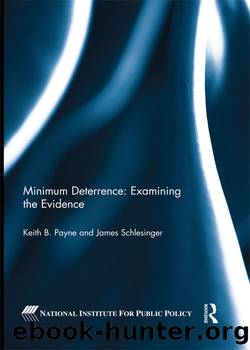Minimum Deterrence: Examining the Evidence by Keith B. Payne James Schlesinger

Author:Keith B. Payne, James Schlesinger [Keith B. Payne, James Schlesinger]
Language: eng
Format: epub
Tags: History, Military, General
ISBN: 9781138781160
Google: djxFoAEACAAJ
Publisher: Routledge
Published: 2014-11-19T16:14:12+00:00
Weapon Numbers and International Events. Nor was the number of nuclear weapons a determinant of the likelihood of events in which the readiness of nuclear forces was raised.244 In Figure4, events during which the United States increased force readiness appear in boldface, those involving Soviet nuclear forces are in italics, and events where both sides enhanced readiness are boldfaced and italicized. Three of these eventsâthe downing of U.S. C-47 air transports over Yugoslavia, the Berlin blockade, and the Korean Warâhappened when the U.S. nuclear arsenal was relatively small (nine weapons in 1946, 50 in 1948, and fewer than 1,200 in the early 1950s, respectively) and the number of Soviet weapons was even smaller (none in 1946 and 1948, and 120 or fewer in the early 1950s), while almost no eventsâthe Soviet reaction to the NATO Able Archer nuclear release command post exercise being the exceptionâoccurred from the late 1970s through the late 1980s, years when each country had more than 20,000 weapons. Six events took place during a period (1956â1962) when the U.S. nuclear arsenal grew rapidly and the smaller Soviet arsenal also increased, although at a slower rate. But there was the same number of events, two, in 1958, when the United States had a little over 7,000 weapons and the Soviet Union had somewhat fewer than 1,000, as there was in 1961â1962, when the U.S. count exceeded 20,000 weapons and the Soviets had roughly 3,000. While the alert of some Soviet nuclear forces during the 1968 Moscow-led invasion of Czechoslovakia occurred as the number of Soviet nuclear weapons was increasing, the U.S. nuclear alert the next year, which was intended to give an impetus to the Vietnam peace negotiations, took place when the number of U.S. nuclear weapons was declining. Both sides alerted their nuclear forces during the 1973 Arab-Israeli War, a time when the total number of U.S. nuclear weapons was nearly twice that of the Soviet Union. In short, Figure4 offers little or no support for the view that more nuclear weapons per se means a greater risk of confrontation, or that reducing nuclear arsenals will lessen the risk.245
Download
This site does not store any files on its server. We only index and link to content provided by other sites. Please contact the content providers to delete copyright contents if any and email us, we'll remove relevant links or contents immediately.
| Africa | Americas |
| Arctic & Antarctica | Asia |
| Australia & Oceania | Europe |
| Middle East | Russia |
| United States | World |
| Ancient Civilizations | Military |
| Historical Study & Educational Resources |
The Radium Girls by Kate Moore(11644)
100 Deadly Skills by Clint Emerson(4705)
The Templars by Dan Jones(4562)
Rise and Kill First by Ronen Bergman(4555)
The Doomsday Machine by Daniel Ellsberg(4255)
The Rape of Nanking by Iris Chang(4029)
Killing England by Bill O'Reilly(3901)
Hitler in Los Angeles by Steven J. Ross(3808)
Stalin by Stephen Kotkin(3732)
12 Strong by Doug Stanton(3424)
Hitler's Monsters by Eric Kurlander(3176)
Blood and Sand by Alex Von Tunzelmann(3067)
Darkest Hour by Anthony McCarten(3019)
The Code Book by Simon Singh(2879)
The Art of War Visualized by Jessica Hagy(2846)
Hitler's Flying Saucers: A Guide to German Flying Discs of the Second World War by Stevens Henry(2633)
Babylon's Ark by Lawrence Anthony(2442)
The Second World Wars by Victor Davis Hanson(2428)
Tobruk by Peter Fitzsimons(2381)
